

ECMWF Director-General Florence Rabier opened the Annual Seminar 2023.
About 100 scientists and students came together from 4 to 8 September 2023 for the Annual Seminar at ECMWF in Reading, UK, to learn about the history and state of the art of Earth system reanalysis activities.
The seminar was also followed daily by up to 68 attendees on the livestream. There were 32 presentations and 22 posters.
Reanalyses provide gapless fields of historical weather and climate, as well as of the land surface, ocean waves, the ocean, hydrology, and atmospheric composition. They are usually a blend of observations with short-range forecasts rerun with modern forecasting models. Reanalyses are very popular datasets that are used for a wide spectrum of applications.
ERA5 is the latest reanalysis that is produced by the EU-funded Copernicus Climate Change Service (C3S) implemented by ECMWF. “ERA5 has well over 125,000 users, ranging from researchers to professional consultants, big data experts, journalists, policy makers and the public,” says ECMWF’s Hans Hersbach, one of the organisers of the Annual Seminar.
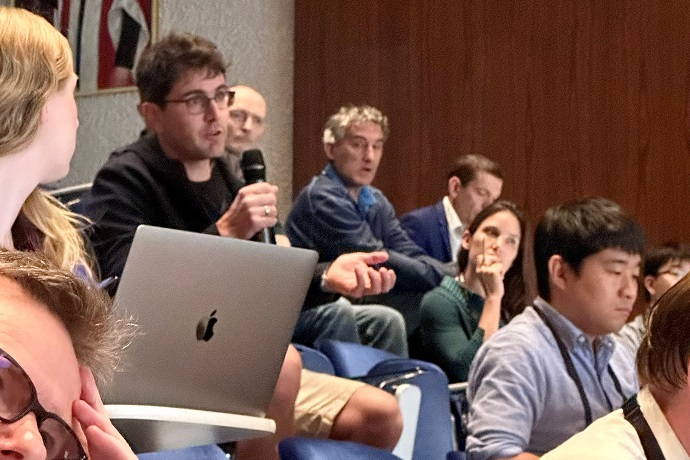
Members of the audience, both in person and online, could ask questions after each presentation.
Here we present some highlights from the presentations.
Overview of reanalysis activities
Reanalysis activities are carried out at several locations around the world, and a few were highlighted in this seminar.
An example is reanalysis performed by NASA’s Global Modeling and Assimilation Office (GMAO). This started with the MERRA and MERRA-2 atmospheric reanalyses and continues with progress towards an integrated Earth system reanalysis.
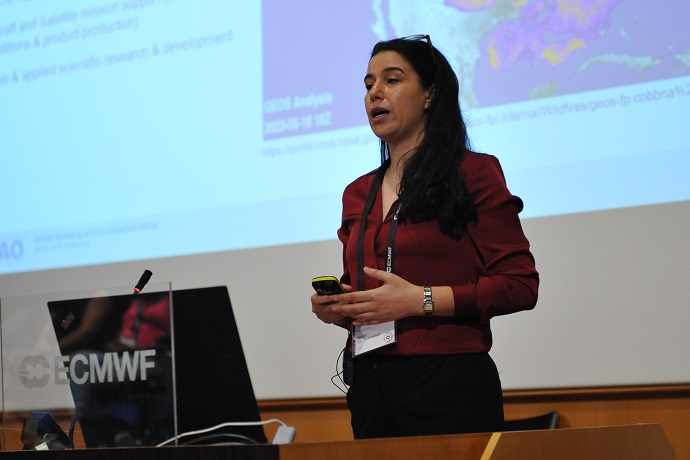
Amal El Akkraoui from NASA GMAO gave a presentation on ‘Reanalysis activities at the NASA Global Modeling and Assimilation Office’.
The Japan Meteorological Agency (JMA) has just released its new JRA-3Q atmospheric reanalysis, according to the poster presentation. In the talks, it was shown how various coupling options between the ocean and the atmosphere were described in the data assimilation model at JMA.
At ECMWF, research into reanalysis goes hand in hand with research into numerical weather prediction (NWP). ECMWF is currently developing the ORAS6/OCEAN6 reanalysis that will be used to provide boundary conditions for NWP, but also for ECMWF’s next atmospheric reanalysis ERA6.
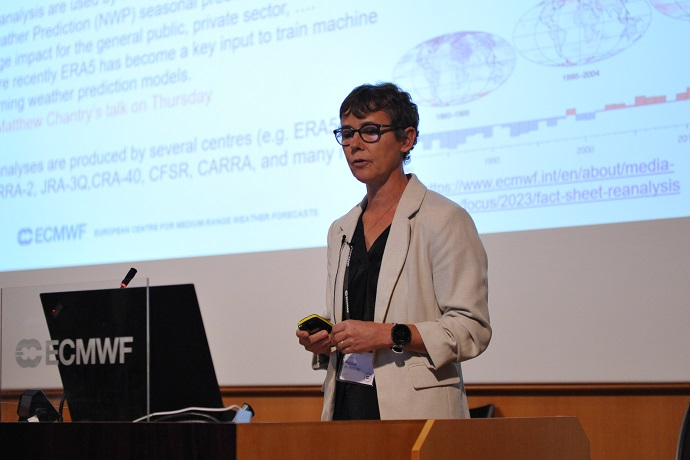
Patricia de Rosnay from ECMWF gave a presentation entitled ‘Towards Earth system reanalysis’.
Although atmospheric reanalysis data assimilation methodology is quite advanced, this is typically less the case for land reanalyses that describe quantities such as 2-metre temperature and humidity, soil moisture and snow. This is true for both GMAO and ECMWF.
Hydrological reanalyses were also presented. They are important for understanding and monitoring water resources and providing early warnings. At ECMWF this is performed at high resolution to capture local river discharge.
Atmospheric composition reanalysis can provide global estimates that can help to evaluate the impact of air quality on health and climate monitoring of anthropogenic activity. Models of sources and sinks are complex. Although in-situ observations go back quite a while, satellite missions providing detailed information on a multitude of chemical species start only in the early 2000s, after the launch of the Envisat and Aura satellites. Ozone satellite records go back further.
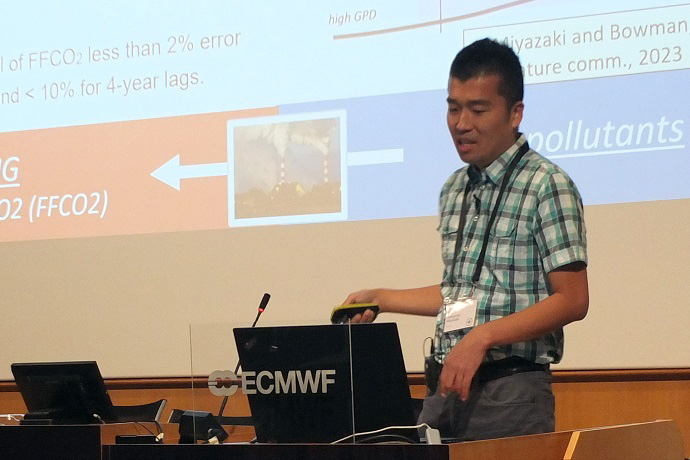
Kazuyuki Miyazaki from the NASA Jet Propulsion Laboratory gave a presentation on ‘Atmospheric composition reanalysis’.
In addition to global reanalysis, regional reanalysis has seen quite an increase in interest in about the last ten years. As an example, the C3S regional and Arctic reanalyses were presented. A reduced domain enables a much higher resolution, which can improve the local realism significantly.
Centennial reanalysis aims to provide a longer sample of extreme weather and climate events. Consistency is key: since the observing system has evolved drastically over time, these products only ingest surface observations. An example is the US 20th Century Reanalysis v3, which goes back nearly 200 years.
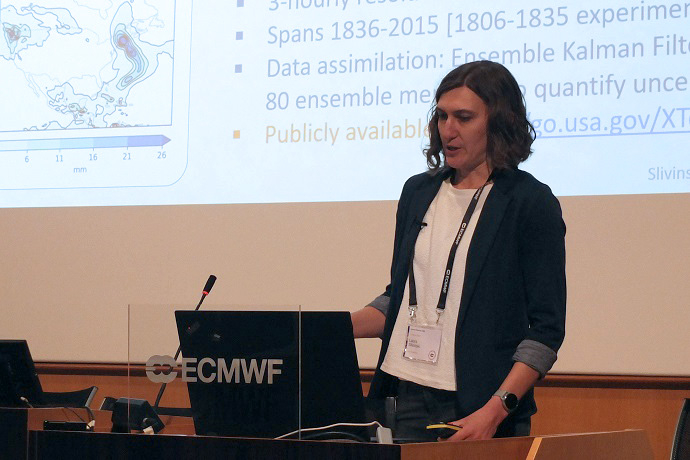
Laura Slivinski from the US National Oceanic and Atmospheric Administration (NOAA) gave a presentation on ‘Centennial reanalysis’.
Going even further back in time, paleoclimate reconstructions have limited or no access to sub-daily observations and must rely on proxy data (tree rings, ice cores) instead. Typically, these provide information at a yearly scale. These products usually follow an ‘offline’ data assimilation method. The example of the Modern Era Reanalysis (ModE-RA) was presented. This provides a global monthly 3D atmospheric reconstruction back to 1421.
Data assimilation methodology
Data assimilation combines observations with a short-range forecast constrained by previous observations to obtain the best possible estimate of the state of the Earth system.
Most advanced reanalysis systems use some form of ensemble Kalman filter, 3D-Var, or 4D-Var data assimilation methods. It was shown how each family of methods makes different assumptions to tackle non-linear and non-Gaussian effects.
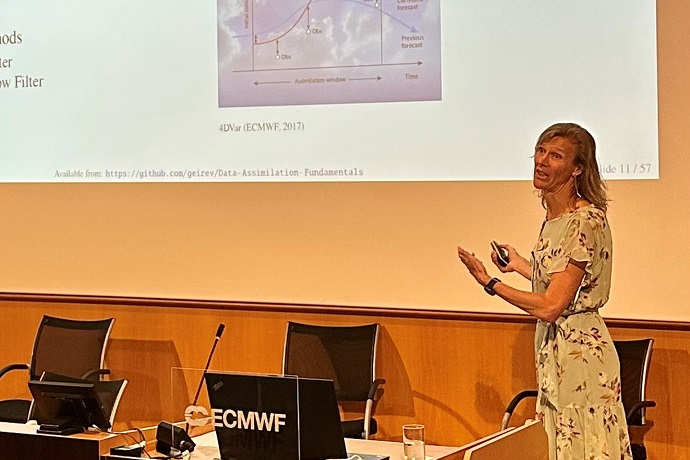
Femke Vossepoel from Delft University of Technology in the Netherlands provided an ‘Overview of data assimilation methods’.
Observations
The observing system typically provides an incomplete non-global picture of the 3D atmosphere or other domains, especially for the past. Fortunately, modern data assimilation methods are often multivariate and enable information to spread across variables.
An example that was presented is to extract wind information from temperature sensitive radiance measurements. Nevertheless, the evolution of the observing system does have a significant impact on accuracy, not only in the horizontal but also in the vertical.
For reanalysis, observation preparation never stops. It was shown how reprocessing and data rescue for both satellite and in-situ observations are essential to improve and enhance the available observing system and to maximize the quality of reanalysis.
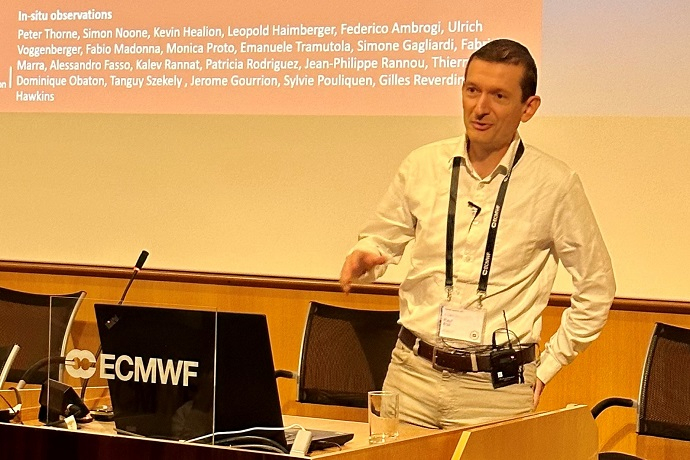
Paul Poli from ECMWF gave a presentation on ‘Data rescue and reprocessing’.
Historical gridded forcing fields
Accurate information on sea-surface temperature (SST) and sea ice cover are essential for our knowledge of the past climate. Although these variables are relatively well observed by satellites from around the 1980s, the situation is very different before, when only in-situ observations, mostly from ships, were made.
The methodology that is used for the HadISST2 product, which provides daily global SST and sea ice cover back to 1850, was described. Reconstructing SST and sea ice data sets is a research-intensive, multi-step process that encompasses homogenisation, bias characterisation, infilling, and uncertainty quantification, inter alia.
Radiative forcing, land cover and land use are typically prescribed as boundary conditions in reanalyses. Although sometimes a crude seasonal cycle is provided, it typically misses the long-term evolution from either natural or anthropogenic sources. It was shown how the lack of such variations is addressed in the EU-funded CONFESS project.
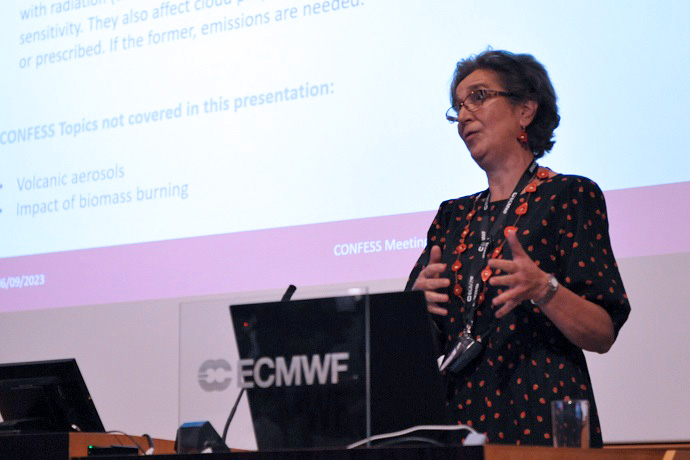
Magdalena Balmaseda from ECMWF gave a presentation entitled ‘Towards consistent representation of the boundary forcing temporal variability in Earth System Reanalysis, reforecasts and climate integrations’.
Validation and inter-comparison of reanalyses
Validation, verification, and evaluation of reanalysis is essential for an insightful use of reanalysis products and their continuous improvement.
One example of a systematic intercomparison activity presented during the seminar is the WCRP SPARC initiative. It has published in-depth reports that evaluate atmospheric processes, including dynamics and transport, as well as composition in the stratosphere.
Other examples are the international Ocean Reanalysis Intercomparison Projects, which focus on the blue (physics), green (biology) and white (ice) ocean.
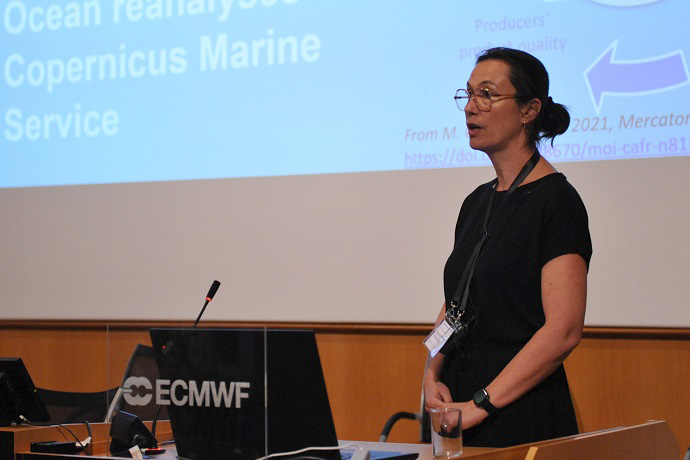
Marie Drévillon from Mercator Ocean in France gave a presentation on the ‘Evaluation of ocean reanalyses’.
First results regarding a comparison between ERA5 and the recently released JRA-3Q reanalyses were presented for precipitation, upper-air parameters, and surface temperature. Although differences do exist, especially locally, the level of agreement is reassuring.
Precipitation on the local scale can be challenging for reanalysis. For an area in Kenya, Africa, comparison with field data in general showed favourable results for ERA5.
Challenges and research
A common challenge in reanalysis is the considerable evolution of the observing system in combination with the presence of systematic model bias, for example in the stratosphere. Ways of dealing with that were presented for ECMWF’s forthcoming ERA6 reanalysis.
For long coupled reanalysis, ocean and sea ice systematic biases are also a key challenge, and covariances in the data assimilation system can erroneously carry these over as well.
The correct representation of extremes is another challenging area for reanalysis. For temperature extremes, though, there is a widespread agreement for long-term changes and inter-annual variations across observational and reanalysis datasets. Larger inconsistencies are found for heavy precipitation extremes, in particular in regions with sparse observational coverage and intense storms.
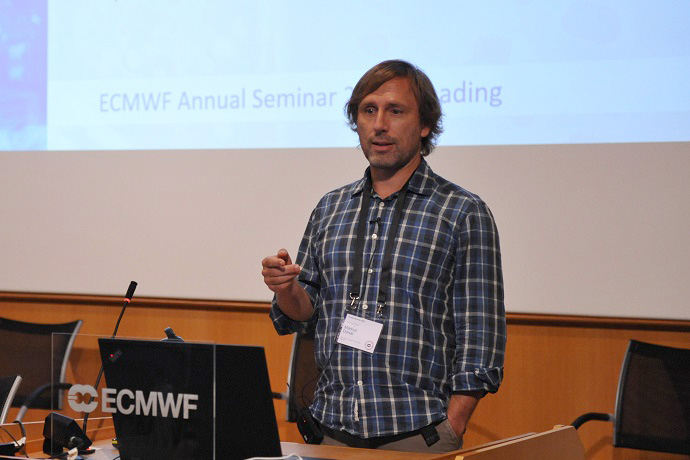
Markus Donat from the Barcelona Supercomputing Center (BSC) in Spain gave a presentation on ‘Extremes in reanalysis and observational products’.
Another challenge discussed in the seminar is quality-assurance during the production phase of reanalysis. Appropriate tools need to be in place to detect anomalies at an early stage. Since consistency is important, the solutions adopted should not affect the model or data assimilation system.
Towards consistent Earth system reanalysis
Now that atmospheric data assimilation uses ensemble-based methods, an opportunity was presented to better unify land and atmospheric data assimilation.
Monitoring of the carbon cycle and understanding the mechanisms of sources, sinks and distribution is essential to understanding the cause and consequences of climate change. Although atmospheric composition reanalysis at ECMWF describes the carbon cycle, there is currently no feedback from this into the atmosphere and land components. Coupling options with the water cycle and vegetation models are being explored.
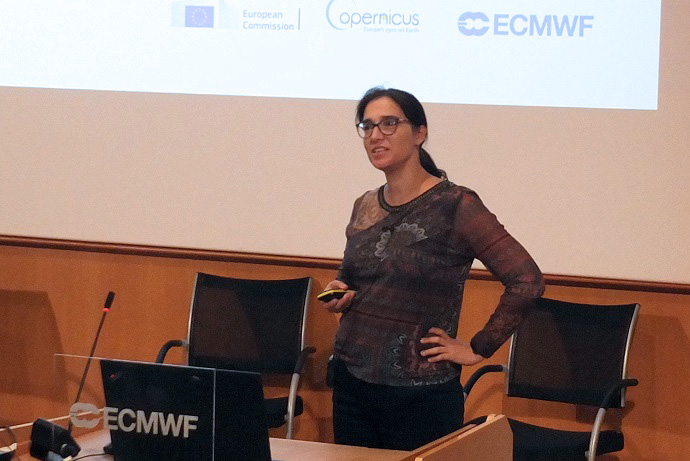
Anna Agusti-Panareda from ECMWF gave a presentation on the ‘Integrated carbon cycle in reanalysis’.
In addition to coupling strategies between various Earth system components, special care is required to extract maximum information from observations that are sensitive to more than one of those components.
Examples are sea-surface temperature sensitive and sea-ice sensitive observations. It was described how, at ECMWF, the extended control vector (XCV) method is used to enable information to be passed on between separate uncoupled data assimilation systems.
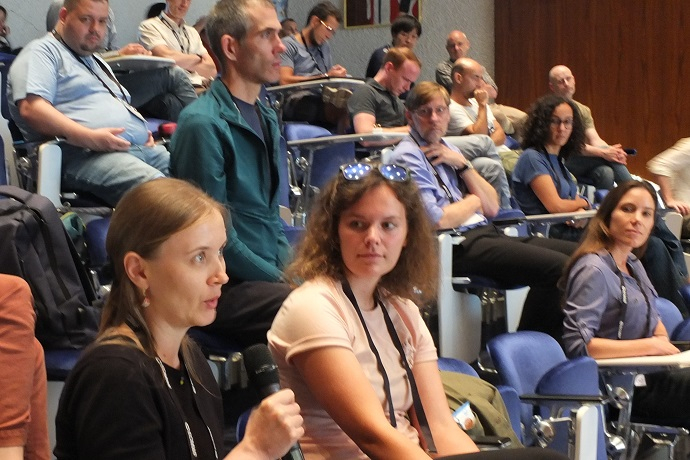
The Annual Seminar finished with a closing discussion.
Further information
Presentation slides and video recordings of all talks are provided on the Annual Seminar 2023 Agenda pages.
